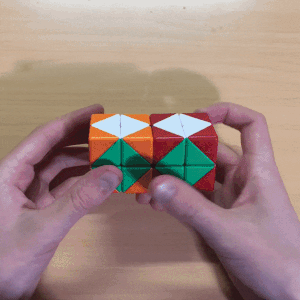Difference between revisions of "Physical 2^4 Methods"
(Created page with "=Notation= Because this is a physical puzzle, we can easily adapt x, y, & z rotations to fit the moves. The puzzle is held horizontally throughout most of the solve, so the L...") |
|||
| Line 4: | Line 4: | ||
=Gyro Algorithm= | =Gyro Algorithm= | ||
| − | + | [[File:GyroGif.gif|thumbnail|left|300px|Gyro algorithm]] | |
From a solved puzzle, there's nothing you can do to change the orbits of the L/R stickers, so we need an algorithm to do a special 4D rotation of the puzzle, called a gyro. <br> | From a solved puzzle, there's nothing you can do to change the orbits of the L/R stickers, so we need an algorithm to do a special 4D rotation of the puzzle, called a gyro. <br> | ||
A commonly used algorithm for the Gyro is: <br> | A commonly used algorithm for the Gyro is: <br> | ||
| Line 13: | Line 13: | ||
<li> Rx2 B2 D2 Lx2</li> | <li> Rx2 B2 D2 Lx2</li> | ||
</ul> | </ul> | ||
| − | Note that the last 2 moves (D2 Lx2) could be replaced by D2 Rx2, U2 Lx2, or U2 Rx2 based on the solver's preference. | + | Note that the last 2 moves (D2 Lx2) could be replaced by D2 Rx2, U2 Lx2, or U2 Rx2 based on the solver's preference. <br> |
| + | Watch [[https://www.youtube.com/watch?v=Et9JuxPFl2g Melinda's 6 Snap Gyro]] for an alternative algorithm. <br> | ||
| + | |||
| + | <br> | ||
| + | <br> | ||
| + | <br> | ||
=Orienting Both Cells= | =Orienting Both Cells= | ||
Revision as of 09:46, 13 August 2022
Contents
Notation
Because this is a physical puzzle, we can easily adapt x, y, & z rotations to fit the moves. The puzzle is held horizontally throughout most of the solve, so the L and R cells can do any x, y, & z rotations freely. The I and O cells can do any x rotation, as well as only y2 or z2 rotations. The other sides have restricted turning due to the projection, and can only do 180 degree twists, so they will just be referred to as U2, D2, F2, B2.
Gyro Algorithm
From a solved puzzle, there's nothing you can do to change the orbits of the L/R stickers, so we need an algorithm to do a special 4D rotation of the puzzle, called a gyro.
A commonly used algorithm for the Gyro is:
- Take the left endcap off and put it on the right so it becomes the right endcap (this brings the puzzle into the inverted state)
- Ly Ry'
- Take the right endcap off and put it on the left so it becomes the left endcap (this brings the puzzle back into the normal state)
- Rx2 B2 D2 Lx2
Note that the last 2 moves (D2 Lx2) could be replaced by D2 Rx2, U2 Lx2, or U2 Rx2 based on the solver's preference.
Watch [Melinda's 6 Snap Gyro] for an alternative algorithm.
Orienting Both Cells
Grant's Method
This method uses NO algorithms! The first step is to get exactly 8 pieces from a opposite colour group oriented to U/D. Then you do a gyro algorithm, which brings those 8 to the L/R stickers. Because you oriented exactly 8, that means that the other 8 are all in good positions to be paired up onto a single cell oriented to U/D. Next, rotate the side that has 8 oriented to U/D like a z or z' such that they are oriented to I/O. Do a gyro algorithm, then undo the last 3 moves of the gyro, and then gyro again.
Rowan's Method
Permuting Both Cells
P4L
CBC
Directly solve one of the cells, then use RKT to solve the other cell
RKT Parity
If you end the solve and a single layer needs twisting by 180 degrees, then do this algorithm with RKT:
- R2 B2 R2 U R2 B2 R2 U
There is also [this] video by Melinda with many alternative algorithms.
